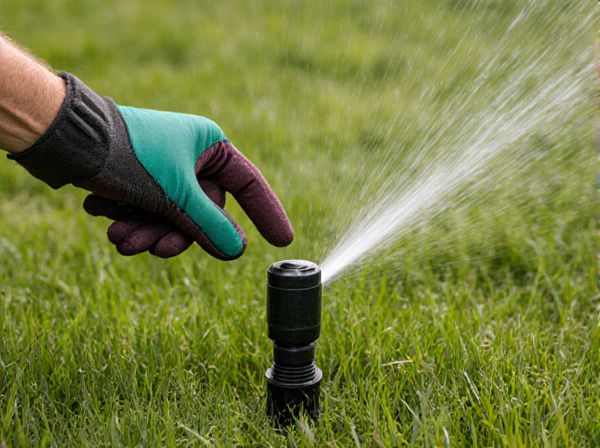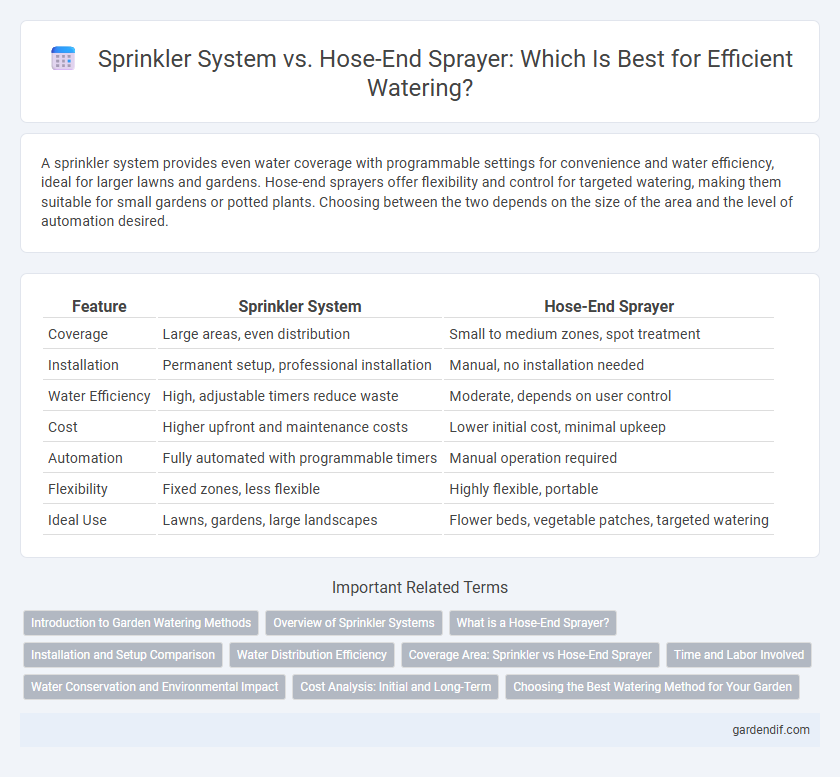
Sprinkler system vs Hose-end sprayer Illustration
A sprinkler system provides even water coverage with programmable settings for convenience and water efficiency, ideal for larger lawns and gardens. Hose-end sprayers offer flexibility and control for targeted watering, making them suitable for small gardens or potted plants. Choosing between the two depends on the size of the area and the level of automation desired.
Table of Comparison
| Feature | Sprinkler System | Hose-End Sprayer |
|---|---|---|
| Coverage | Large areas, even distribution | Small to medium zones, spot treatment |
| Installation | Permanent setup, professional installation | Manual, no installation needed |
| Water Efficiency | High, adjustable timers reduce waste | Moderate, depends on user control |
| Cost | Higher upfront and maintenance costs | Lower initial cost, minimal upkeep |
| Automation | Fully automated with programmable timers | Manual operation required |
| Flexibility | Fixed zones, less flexible | Highly flexible, portable |
| Ideal Use | Lawns, gardens, large landscapes | Flower beds, vegetable patches, targeted watering |
Introduction to Garden Watering Methods
Garden watering methods vary significantly, with sprinkler systems offering automated, wide-coverage irrigation ideal for lawns and large gardens. Hose-end sprayers provide targeted water delivery, allowing precise control for flower beds and vegetable patches. Choosing between these options depends on garden size, water efficiency needs, and maintenance preferences.
Overview of Sprinkler Systems
Sprinkler systems provide automated and uniform water distribution across large lawns and garden areas, ensuring efficient irrigation with minimal water waste. These systems can be programmed to operate at specific times, promoting consistent soil moisture levels and healthier plant growth. Compared to hose-end sprayers, sprinkler systems offer enhanced convenience and coverage through fixed or pop-up heads tailored for various landscape designs.
What is a Hose-End Sprayer?
A hose-end sprayer is a garden tool that attaches directly to a standard garden hose, allowing users to mix and apply liquid fertilizers, pesticides, or herbicides evenly across lawns and plants. It offers a portable and cost-effective solution by combining watering and treatment in a single step without requiring a separate pump system. Hose-end sprayers provide precise control over spray concentration and coverage, making them ideal for targeted application in smaller to medium-sized garden areas.
Installation and Setup Comparison
Sprinkler systems require professional installation or detailed setup involving underground piping, timers, and multiple sprinkler heads, providing automated and zone-specific watering. Hose-end sprayers offer simpler, DIY setup by attaching directly to a garden hose, allowing manual control but less precise water distribution. The installation time for sprinkler systems is significantly longer and more complex compared to the quick, tool-free attachment of hose-end sprayers.
Water Distribution Efficiency
Sprinkler systems provide uniform water distribution over large areas, optimizing water usage by delivering consistent coverage through adjustable nozzles and timed settings. Hose-end sprayers offer targeted watering but often result in uneven distribution, leading to potential water waste and insufficient irrigation. Efficient water distribution in sprinkler systems reduces runoff and promotes healthier plant growth by maintaining consistent soil moisture levels.
Coverage Area: Sprinkler vs Hose-End Sprayer
Sprinkler systems typically cover larger areas, efficiently distributing water across lawns and gardens with adjustable spray patterns suitable for various landscapes. Hose-end sprayers are generally designed for smaller, targeted zones like flower beds or shrubs, offering precise application but limited overall coverage. Choosing between the two depends on the size and complexity of the watering area, with sprinklers better for broad spaces and hose-end sprayers ideal for focused watering needs.
Time and Labor Involved
A sprinkler system automates watering schedules, significantly reducing the time and physical effort required compared to hose-end sprayers, which demand manual setup, adjustment, and relocation. Hose-end sprayers often require continuous monitoring and repositioning, increasing labor intensity and making them less efficient for larger areas. Sprinkler systems optimize irrigation with programmed timers, freeing users from daily watering tasks and minimizing labor.
Water Conservation and Environmental Impact
A sprinkler system delivers water evenly across large areas, minimizing runoff and evaporation by using programmable timers and precise nozzles, which enhances water conservation significantly. Hose-end sprayers, while convenient for targeted watering, often result in uneven application and higher water waste due to manual operation and potential over-spraying. Choosing a sprinkler system reduces environmental impact by optimizing water usage, lowering excess water runoff, and decreasing energy consumption associated with water pumping.
Cost Analysis: Initial and Long-Term
A sprinkler system typically involves higher initial costs, ranging from $500 to $2,500 depending on installation complexity, but offers long-term savings through automated watering and efficiency, reducing water bills by up to 30%. Hose-end sprayers have lower upfront expenditures, generally costing between $20 and $100, but may increase ongoing water usage and labor time, leading to higher cumulative expenses over several seasons. Evaluating cost-effectiveness requires balancing the upfront investment against potential water conservation and maintenance savings over time.
Choosing the Best Watering Method for Your Garden
A sprinkler system offers automated, consistent watering coverage ideal for large gardens and lawns, ensuring efficient use of water with programmable timers that reduce waste. Hose-end sprayers provide greater control over application rate and are well-suited for targeted watering, such as flower beds or vegetable gardens, allowing customization with various spray patterns. Selecting the best method depends on garden size, plant types, water efficiency goals, and the convenience level desired for regular maintenance.
Sprinkler system vs Hose-end sprayer Infographic

 gardendif.com
gardendif.com